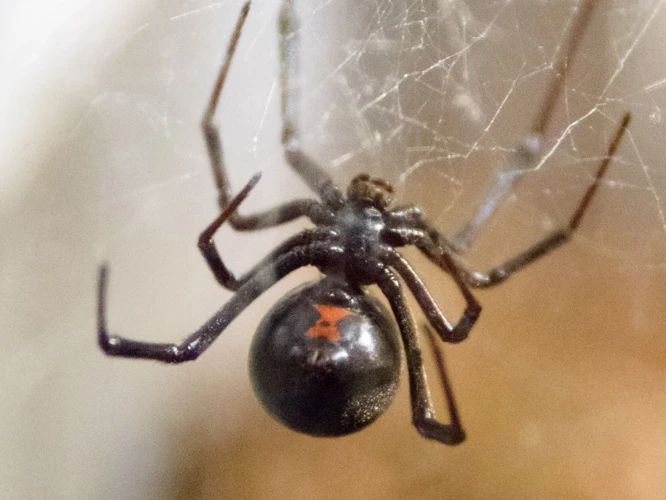As we explore the wonders of the animal kingdom, we come across some of the most fascinating and mysterious creatures that lurk in the shadows. One such creature is the Black Widow Spider. These arachnids are well-known for their venomous bite and ominous appearance, which leaves many people with a sense of fear and perplexity. In this article, we will delve into the world of Black Widow Spiders and uncover some fascinating facts about their behavior, habitat, and, most importantly, their venomous bite. So, grab a cup of coffee and let’s explore the enigmatic world of the Black Widow Spider.
What is a Black Widow Spider?
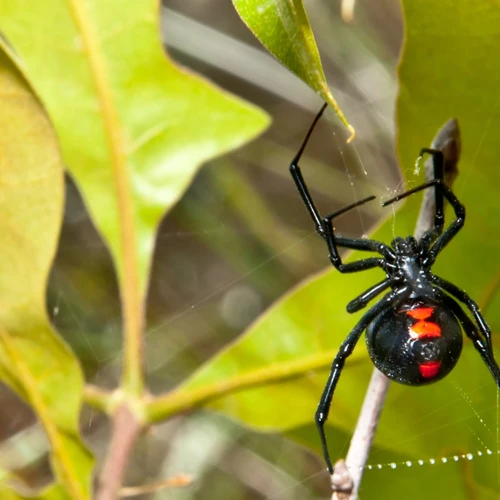
Are you familiar with the infamous Black Widow Spider? These venomous creatures have garnered a notorious reputation due to their potent venom and dangerous bite. Black Widows can be found in various areas of the world, but are most commonly found in North America. In this section, we will take a closer look at the appearance and behavior of Black Widows. We will also explore what makes their bite so venomous, including the symptoms and treatment options.
Appearance
Black Widow Spiders are notorious for their dark and shiny appearance. The female of the species is easily distinguishable by her shiny black color with a distinct red hourglass shape on her abdomen. Adult females generally measure around 13 mm, while adult males are around half that size. Male Black Widow Spiders have a smaller and narrower abdomen, duller coloration, and lack the red hourglass pattern.
These spiders are also known for their characteristic body shape, with a round cephalothorax (the fused head and thorax) and a bulbous abdomen. They have eight legs which are covered in short bristly hairs. These hairs give the spider a velvety texture. Apart from these unique features, Black Widow Spiders also have a distinctive claw on the end of each leg that helps them climb up surfaces.
One of the most interesting things about these venomous spiders is that their bodies are made up of two parts: the prosoma, which is the front part or the cephalothorax, and the opisthosoma, which is the back part or the abdomen. The prosoma consists of the head, thorax, and the eight legs, while the opisthosoma is the reproductive system and a storage area for venom glands.
The coloring and shape of Black Widow Spiders help them to camouflage themselves in their preferred environment, which is in dark, dry, and secluded locations such as under rocks, shrubs, and logs. They are most active at night and can be found in areas where insects are abundant.
With their striking appearance and potent venom, Black Widow Spiders have long been the subject of fascination and fear. To learn more about how to prevent a bite from one of these creatures, check out our article on how to avoid Black Widow Spider bites.
Behavior
Black widow spiders are known for their distinctive appearance and venomous bite, but their behavior is also unique and fascinating. These spiders are generally solitary and nocturnal, and their behavior can vary depending on their environment and the presence of prey.
Feeding behavior: Black widow spiders are carnivorous, and their primary prey includes insects and other small arachnids. They are known for their venomous bite, which they use to immobilize their prey before consuming it. Adult female black widow spiders are capable of cannibalism, and will occasionally attack and consume males after mating.
Mating behavior: Male black widow spiders often attempt to mate with females multiple times, but they face the risk of being cannibalized during or after mating. In response, male black widow spiders have evolved behavioral adaptations to minimize their risk of being eaten, such as leaving a small amount of sperm behind after mating or choosing to mate with less aggressive females.
Reproductive behavior: Female black widow spiders are known for their distinctive egg sacs, which are round and smooth and typically contain several hundred eggs. Depending on the species, the female may spin a new web to shelter the egg sac or attach it to an existing web. The female will guard the egg sac and newly hatched spiderlings for several weeks until they are mature enough to disperse on their own.
Black widow spider behavior is a fascinating and complex topic that continues to be studied by scientists. Understanding their behavior is crucial for understanding how to prevent bites and how to effectively treat them if they do occur. For more information about black widow spiders and their venomous bite, check out the medical importance of black widow venom.
The Venomous Bite
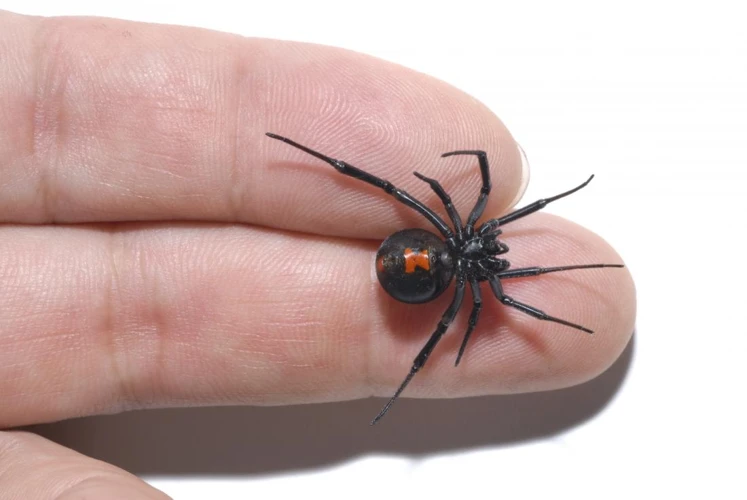
The Venomous Bite of a Black Widow Spider: What You Need to Know
Black Widow spiders are known to have one of the strongest and most potent venoms in the world. Their venom is said to be 15 times more potent than that of a rattlesnake, and it can cause serious medical complications if not treated promptly. In this section, we will explore the symptoms and treatment of a Black Widow spider bite and delve into the fascinating science behind their venom. For more information on the life cycle and distribution of Black Widow spiders, check out our article on Black Widow Spider Life Cycle and Venom.
Symptoms
When a black widow spider bites, it injects venom into its victim. The venom contains neurotoxins that affect the nervous system and can cause several symptoms. Here are some of the possible symptoms of a black widow spider bite:
| Symptom | Description |
|---|---|
| Pain | The bite of a black widow spider can be very painful, often described as a sharp pinprick or burning sensation. The pain may begin at the bite site but can spread to other parts of the body. |
| Muscle cramps and spasms | The venom of a black widow spider can cause muscle cramps and spasms, usually starting in the abdominal muscles and spreading to the back, chest, and limbs. These can be severe and may last for several days. |
| Sweating | The venom can cause sweating, especially around the bite site. The sweat may be profuse and can cause the skin to feel clammy or sticky. |
| Headache | A black widow spider bite can cause a headache, which may be mild or severe. |
| Nausea and vomiting | The venom can cause nausea and vomiting, which may occur soon after the bite or several hours later. |
| High blood pressure | The venom can cause a temporary rise in blood pressure, which can cause symptoms such as headache, dizziness, or blurred vision. |
| Restlessness and anxiety | Some people may feel restless, anxious, or agitated after a black widow spider bite. |
| Weakness or tremors | The venom can cause weakness, tremors, or other neurological symptoms. |
It is important to note that not everyone who is bitten by a black widow spider will experience all of these symptoms. In some cases, the symptoms may be mild or even absent. However, if you suspect that you have been bitten by a black widow spider and experience any of these symptoms, it’s important to seek medical attention immediately. Delaying treatment can result in serious complications or even death.
Treatment
Treatment of a black widow spider bite should be sought immediately, especially if you are experiencing symptoms such as severe muscle cramps, abdominal pain, or tightness in the chest. The good news is that with prompt medical attention, fatalities from black widow spider bites are rare. Here are some steps to take if you are bitten by a black widow spider:
| Treatment | Description |
|---|---|
| Clean the wound | Wash the affected area with soap and water to prevent any bacteria from entering the bite wound. Cover the wound with a clean, dry dressing. |
| Apply ice | Apply ice to the bite area to help reduce swelling and pain. You can also take over-the-counter pain relievers such as ibuprofen or acetaminophen if needed. |
| Seek medical attention | If you experience severe symptoms or an allergic reaction, it is important to seek medical attention immediately. Your doctor may give you antivenom, which is a medication that can counteract the effects of the black widow spider venom. |
It’s important to note that children and the elderly are more at risk for severe symptoms and should seek medical attention right away. Also, avoiding black widow spiders by taking preventative measures can greatly reduce the likelihood of being bitten and requiring medical treatment.
If you want to learn more about black widow spider bites, you can read our related articles such as “The Pain of Black Widow Venom” or “Ancient Origins of Black Widow Venom and Its Effects on the Brain”.
How to Prevent a Bite
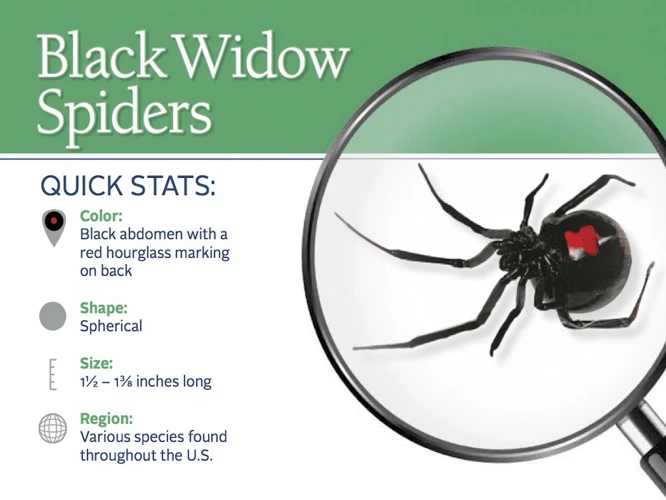
Prevention is the best approach: it is always better to minimize the chances of getting bitten by a black widow spider than dealing with its venomous effects. The following precautions can help reduce the risk of a bite:
- Wear protective clothing: When venturing into outdoor areas where black widows could be living, it’s best to wear long pants and long-sleeved shirts. This will help reduce the amount of exposed skin that could be bitten.
- Shake out clothes and shoes: Before wearing any clothing or shoes that were left outside or stored for a long time, it is important to shake them out thoroughly. This will avoid accidentally awakening any dormant black widow spiders.
- Check bedding and towels: Black widow spiders can sometimes find their way into homes. It’s a good idea to shake out and inspect bedding and towels before use, especially if they were stored in a closet or an attic.
- Keep the house clutter-free: Although it is not always possible, reducing the amount of clutter in and around the house can help eliminate hiding spots for black widow spiders.
- Keep your house clean: Regular cleaning of the house, especially in areas where spiders are most commonly found, can help remove any webs and eggs, reducing the chances of exposure to a black widow.
- Use insecticides: Insecticides available in sprays and dust can be an effective way to kill spiders and other insects. It is important to read and follow the instructions carefully and safely when using these products as they can be toxic.
By following these precautions, the chances of getting bitten by a black widow spider can be reduced considerably. Remember, prevention is always better than cure.
Where are Black Widow Spiders Found?
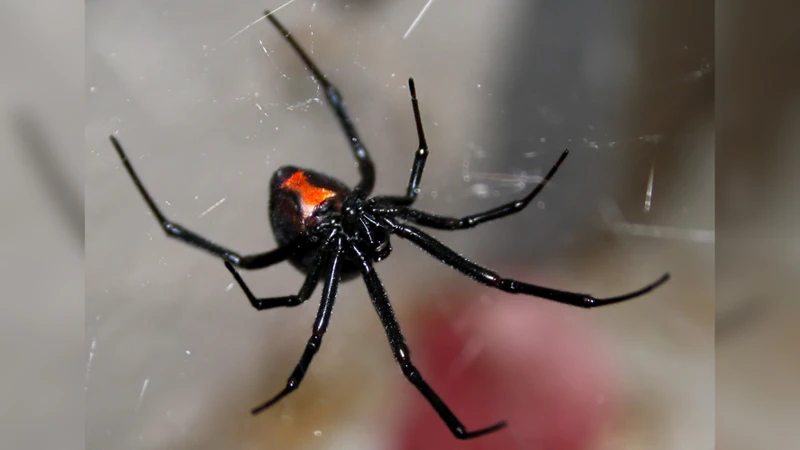
For those who are curious about the whereabouts of the infamous Black Widow Spider, there are certain key details you may want to know. Black Widow Spiders are notorious for their toxic bite, so knowing where they can be found may help you take precautions to avoid them. From the habitat they live in to their distribution, understanding the living patterns of a Black Widow Spider is important in order to protect yourself from harm.
Habitat
Black Widow Spiders are often found in places that are warm and undisturbed, and their habitat varies depending on the species. Some of the common areas where Black Widow Spiders like to dwell include woodpiles, sheds, garages, and cluttered areas. They particularly enjoy hiding in dark and humid places such as basements, crawl spaces, and attics. They can also be found in outdoor areas such as gardens, rock piles, and tall grasses.
Most Black Widows prefer to build their webs near ground level, and their webs are known for being irregular and messy. The spider will often build a funnel out of silk and wait for their prey to come to them before striking with their venomous fangs. While these spiders prefer to be left alone, encounters with humans can be common.
It is important to note that Black Widow Spiders are not always aggressive and only bite as a defense mechanism when they are feeling threatened. It is important to be aware of their habitats and avoid them if possible. In case of an encounter with a Black Widow Spider, any sudden movement or disturbance can provoke the spider to bite, so it is best to keep a safe distance and seek professional help if necessary.
Interesting Fact: Did you know that there are different species of Black Widow Spiders that have adapted to survive in different types of climates? For example, the Northern Black Widow Spider can be found in cooler regions and is more tolerant to cold temperatures, while the Western Black Widow Spider prefers hot and dry climates.
To learn more about the venomous bite of a Black Widow Spider, check out this article about the evolutionary development of their venom, or read about the effects of a Black Widow Spider bite on the immune system in this other article.
Distribution
Black Widow spiders can be found in most of the warmer regions of the world, including the Americas, southern Europe, Africa, Asia, and Australia. In North America, they are most commonly found in the southern and western states. Black Widows like to make their homes in dark, undisturbed places, such as woodpiles, garages, and sheds.
Interestingly, the distribution of Black Widows in the United States has grown in recent years due to the spread of the brown widow spider. Brown widow spiders are similar in appearance to their Black Widow counterparts, but their venom is less potent. As a result, the brown widow spider has been slowly displacing the Black Widow spider in many parts of the United States.
Did you know: The Black Widow spider is often confused with the False Black Widow spider, which is a less venomous species. To learn more about the anatomy of a Black Widow spider’s fangs and venom, click here.
It’s important to know where Black Widow spiders are commonly found so you can take precautions to avoid them. To learn about the potential dangers of a Black Widow spider bite, click here.
To avoid being bitten by a Black Widow spider, it’s important to know where they like to make their homes. Check your surroundings for potential spider habitats, such as piles of wood, rocks, and garages. Keeping your living areas clean and well-lit can also go a long way in keeping these arachnids away.
Interesting Facts About Black Widow Spiders
When it comes to the black widow spider, there are numerous interesting things to consider. One of the most notable facts is that black widow spiders are actually cannibals. A female black widow spider has been known to eat her mate after mating with him. This is not always the case, but it happens quite often in the spider’s natural habitat.
Another interesting fact about black widow spiders is that it is only the female black widow that is considered lethal to humans. The male black widow spider is actually harmless and doesn’t pose any threat to humans. In fact, male black widow spiders rarely bite humans, and even when they do, their venom is not as toxic as the female’s.
Interestingly enough, black widow spider venom is fifteen times stronger than the venom of a rattlesnake. It’s amazing how such a small creature can contain such a potent venom. The toxin present in the black widow spider’s venom is actually a neurotoxin, meaning that it targets the nervous system. When a person is bitten by a black widow spider, they can experience severe muscle pain and cramps, spasms, and tremors.
Black widow spiders are also very secretive creatures. They prefer to stay in dark, quiet spaces such as closets, wood piles, or abandoned buildings. This makes them hard to spot and even harder to avoid. It is crucial to take preventive measures if living in an area where black widow spiders are native.
Finally, black widow spiders are not just a American species, they can be found in other parts of the world as well. In fact, there are over 30 different species of black widow spiders scattered across the globe. However, it’s the American black widow spider that is the most notorious and deadly.
The black widow spider is a small but deadly creature that deserves respect and caution. With their unique characteristics and interesting habits, the black widow spider is a fascinating addition to the world of arachnids. Want to learn more about male black widow spiders? Check out our article on male black widow bites on humans.
Conclusion
In conclusion, the black widow spider, with its venomous bite, can be a dangerous predator to humans and animals alike. While their striking appearance and elusive behavior may make them fascinating to observe, it’s vital to keep a safe distance and take preventative measures against being bitten.
If you are bitten by a black widow spider, it is essential to seek medical attention immediately. The symptoms can escalate quickly and potentially lead to life-threatening complications. Therefore, it’s better to be safe than sorry and seek professional help as soon as possible.
To prevent a black widow spider bite, make sure you are knowledgeable about their natural habitat and behavior, and take appropriate measures to avoid contact. Keep your house clean and tidy, wear protective clothing when necessary, and be cautious when handling firewood or other objects stored for a prolonged period.
While these spiders are predominantly found in the southern United States, they can also be found in other parts of the world. It’s always good to be aware of your surroundings, especially if you’re traveling to new areas, to take precautions and prevent a bite from occurring.
Overall, understanding the black widow spider and its unique characteristics can help you stay safe and informed. Take the time to educate yourself, and never hesitate to seek professional help in the event of a bite. Stay safe, be cautious, and respect these fascinating creatures from a distance.
Frequently Asked Questions
What is the scientific name for the Black Widow Spider?
The scientific name for the Black Widow Spider is Latrodectus.
What is the size of a Black Widow Spider?
A female Black Widow Spider is typically about half an inch long, while a male Black Widow Spider is smaller in size, measuring only a quarter inch long.
What does a Black Widow Spider bite feel like?
A Black Widow Spider bite may feel like a pinprick, but the pain can quickly become more severe, feeling like a muscle ache or cramping sensation.
How toxic is the venom from a Black Widow Spider bite?
The venom from a Black Widow Spider bite is highly toxic and can cause serious symptoms in some individuals, including nausea, tremors, and muscle paralysis.
How long does it take for symptoms to appear after a Black Widow Spider bite?
Symptoms can appear within just a few minutes to several hours after a Black Widow Spider bite.
Can a Black Widow Spider bite be fatal?
While rare, a Black Widow Spider bite can be fatal, especially in young children, elderly individuals, and those with weakened immune systems.
What is the best way to prevent a Black Widow Spider bite?
To prevent a Black Widow Spider bite, it is best to wear gloves and long sleeves when working outdoors, shake out clothing and shoes before putting them on, and remove debris and clutter from around the home.
What is the difference between male and female Black Widow Spiders?
Male Black Widow Spiders are smaller in size and do not possess venom as strong as females. They also have distinct markings on their abdomens.
Do all Black Widow Spiders have a red hourglass marking on their abdomen?
No, while the red hourglass marking is a well-known characteristic of female Black Widow Spiders, not all may have it. Some may have markings that resemble dots or bars.
What is the lifespan of a Black Widow Spider?
The lifespan of a Black Widow Spider is typically around one year, although some females may live up to three years in optimal conditions.

